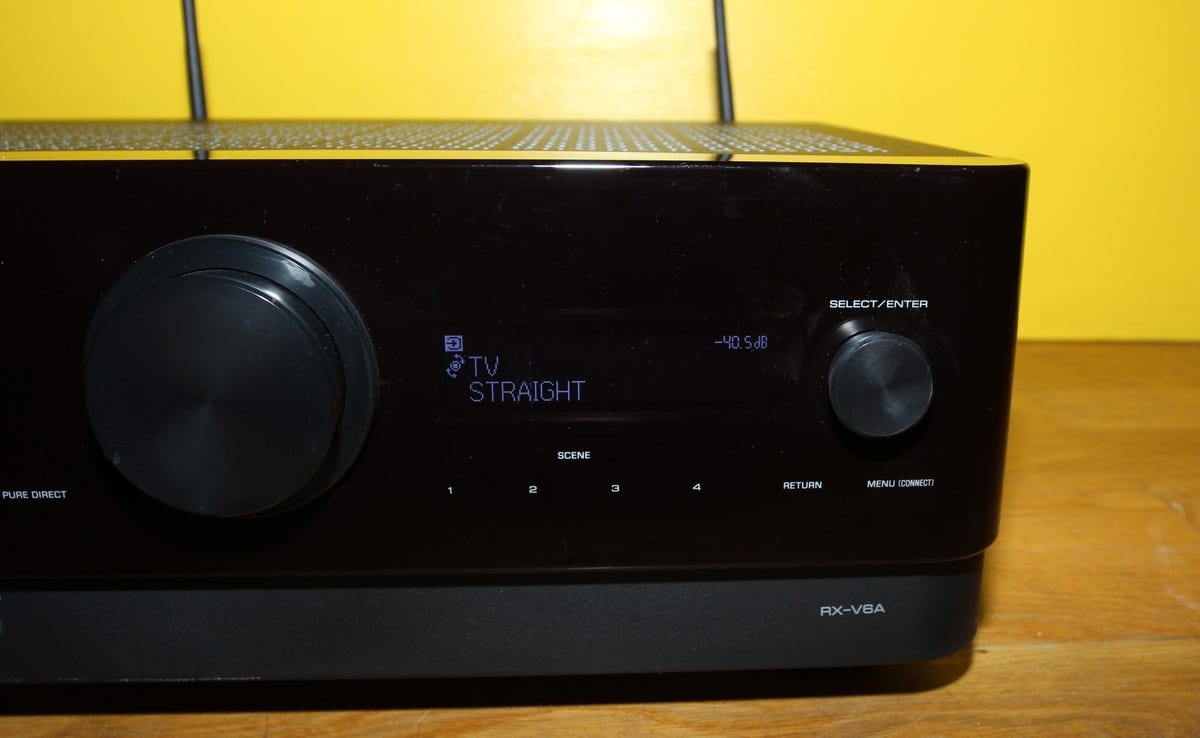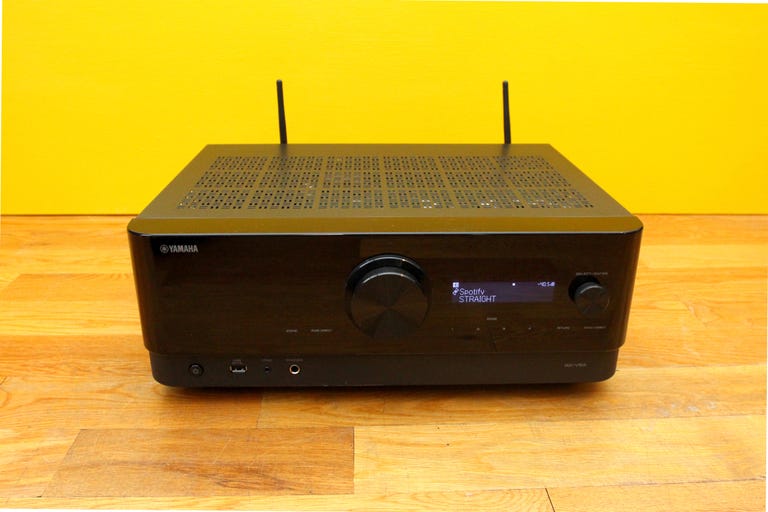 Why You Can Trust CNET
Why You Can Trust CNET Yamaha RX-V6A Review: The Future Sound of Entertainment
The feature-packed AV receiver pairs a fresh design with excellent performance for movies and music.
The waters around AV receivers drift rather than rage. Compared to TVs and soundbars, change comes slowly to these big, black boxes. The Yamaha RX-V6A is a refreshing splash in a pool that has stagnated in recent years. With rounded good looks reminiscent of high-end brands like Classe, paired with a laundry list of futuristic features, this is the most forward-looking receiver I have seen in a long time.
Like
- Outstanding looks (for a receiver)
- Sounds engaging with music and movies
- Supports the latest 4K/120Hz input for gamers
- Up-to-date feature set and connections
Don't like
- LCD display can be hard to read
- No built-in Chromecast
Looks aren't anything without the performance to back them up, and the RX-V6A served up great sound quality in my listening tests. This midpriced receiver RX-V6A offers Dolby Atmos playback and plenty of music replay options too, making it as comfortable with an episode of Hawkeye as it is with an impromptu dance party.
It's worth noting that late '20/early '21 versions of the Yamaha RX-V6A had a bug preventing them from playing 4K/120Hz material. but the company replaced the HDMI boards for older versions in early 2022. I have tested both the upgraded and existing receivers and can advise that the new version is 4K/120Hz compatible.
It's got some more quirks -- the speaker outputs are arranged in an unusual order and that LCD display is harder to read than an LED -- but overall this Yamaha is simply more fun than its competitors. I'm hopeful that the RX-V6A is the spark that ignites a rethink on AV receivers and helps bring the category back into the mainstream.
Editor's note, Feb. 16, 2023: Due to a recent $200 price increase, and the availability of the Sony STR-AN1000, I have adjusted the Yamaha's rating from 8.3 to 8.1. It's worth noting the TSR-700 is identical -- it's an exclusive model for some outlets -- and you can find it for a much more affordable $550 here at Amazon.
Connect all your stuff
The RX-V6A is a 7.1-channel receiver with Dolby Atmos and DTS:X playback, and 100 watts per channel. While the receiver has nine amplified channels it can't be used in a 5.1.4 configuration as one pair is a dedicated Zone 2. Nevertheless, the specification sheet isn't the first thing that catches the eye.

The Yamaha RX-V6A's rounded, glass-like fascia is a real departure from the black shoe boxes of Sony, Denon and Onkyo. The edges are curved in a way I've never seen before, but it doesn't look ostentatious. The front houses a centered volume control and high-res LCD display that looks smart but isn't all that bright. It's off-centered so if you're sitting off to the left it's more difficult to read, even at maximum brightness. I prefer the LED readouts found on competitors.
This receiver couldn't be "the future" without a thoroughly up to date spec sheet and the RX-V6A doesn't skimp. It includes seven HDMI inputs, three of which are 8K-compatible HDMI 2.1 ports ports designed to support the Xbox Series X, PlayStation 5 and PC graphics cards such as the Nvidia RTX 3090. Yamaha claims this is more 2.1 ports than any other brand, and the inputs offer such goodies as auto low latency mode and quick media switching. The receivers also support longer HDMI cable runs with its own bolstered power supply.
Most receivers, including past Yamahas, place the L/R speaker output at the left of the panel, which is followed by the center and then the rears. For whatever reason the RX-V6A places the front pair in the middle instead of the left, which could be confusing -- especially if you're bent over it in a darkened theater setting. It won't take long to remember which output is which, and once you get your speakers connected it's not a big deal.
The RX-V6A may not be as fully loaded when it comes to Wi-Fi streaming support when compared to our previous Editors' Choice winner, the Onkyo TX-NR696, but it still offers something for most people. Yamaha's MusicCast multiroom system is one of the best integrated systems, and it also enables the use of Yamaha smart speakers as rears. The receiver offers AirPlay 2, Spotify Connect and Bluetooth too, although it lacks Chromecast built-in. It can be controlled via Alexa, Google Assistant and Siri-enabled devices, but the commands are mostly basic -- mainly volume, input and next/previous track controls.
The receiver comes with a remote control that offers a variety of functions, including a dedicated Bluetooth button. It's bright and cheery plus offers a zone 2 control switch for more flexibility.
Though the physical aesthetics have been soundly improved, the on-screen display is a small step back. The interface features blocky white and blue icons, whereas competitors such as Sony offer more user-friendly interfaces with bigger icons and better hand-holding for newcomers.
This is the future of sound
I compared the Yamaha RX-V6A against a competitive receiver, the Denon AVR-S960, and found myself returning to listen to the Yamaha more often. While the Denon is relaxed-sounding, the Yamaha offers more home theater thrills and pep when listening to your favorite tunes. Simply put, the Yamaha sounds more fun.
I started my testing with an underrated classic -- the Iron and Wine/Calexico collaboration EP, In The Reins. When streaming via Roon to the Oppo UDP-203 and then letting the receivers decode, the Yamaha had a solid, three dimensional sound. Through it Sam Beam's voice was more firmly rooted in space, and the backing vocals a little easier to discern than on the Denon.
Receivers that are tuned for movies are rarely good with music -- they can sound overly harsh and tiring -- but the tambourine-forward sound of Spoon's You Got Yr. Cherry Bomb sounded fuller on the Yamaha than the Denon. The song's chugging bass underpinned the percussion in the hands of the V6A and the entire production sounded less thrashy and more composed. The Denon was a shade subtler but didn't make me sit up in my seat in the same way.
Turning to home theater with Avatar, the Yamaha driving a pair of Bowers and Wilkins 603 S2 speakers sounded bigger and more effortless than any soundbar I've heard. The opening dialog of the Thanator chase scene was more intelligible too, and certainly better than the JBL Bar 2.1 Deep Bass soundbar, for example. It may not have had the same booming effect on the creatures' footfalls, but this was easily tweaked via the Yamaha menu.
After that tweak the Yamaha had bass effects I could actually feel with my feet and, compared to the Denon, I found it sounded more atmospheric, but the bass still wasn't as impactful.
After this review was first published I also compared the Yamaha RX-V6A against the Onkyo TX-NR6100 and found the Yamaha was a better performer there too. The Onkyo is more expensive, though this is offset by its superior streaming connectivity over the Yamaha.
4K/120Hz compatibility
The "4K/120Hz bug" is a problem that affected the first crop of 8K receivers from Marantz, Denon and Yamaha. All of 2020's 8K-compatible receivers were unable to display variable refresh rate video, and they didn't support 4K/120Hz video from the Xbox Series X or nVidia RTX30-series video cards. As of late 2022 all the models now being sold on the market should be compatible with 4K/120Hz signals, and Denon, Marantz and Yamaha have announced fixes for older models. If you have an Yamaha RX-V6A you can check its compatibility here).
Yamaha sent me a new RX-V6A unit with an updated 8K board, which I tested with an Xbox Series X connected. I found I was able to toggle between 4K/60Hz and 4K/120Hz without an issue, unlike with the original 2020 version, which simply gave me a blank screen. I was then able to play the 4K/120Hz-compatible game Call of Duty Black Ops Cold War without a hint of tearing or other video artifacts. It also looked super-smooth in 4K/60Hz mode however, so for this game at least, there was little obvious benefit from the higher refresh rate.
Should you buy it?
If you're trying to decide between the Yamaha and the Denon, both sound quality and features come into play. The Yamaha offers an extra HDMI port than the Denon and Onkyo and more 8K-compliant 2.1 ports too. The RX-V6A also looks better and sounds more entertaining than both.
The receiver doesn't get everything right -- that LCD display is a misstep -- and I still prefer the Onkyo TX-N6100's streaming capabilities and better display. Yet, if you're looking for one of the best-sounding receivers released in the past twelve months, and one which has the most up-to-date 8K specification, the Yamaha is the future-looking model to buy.


